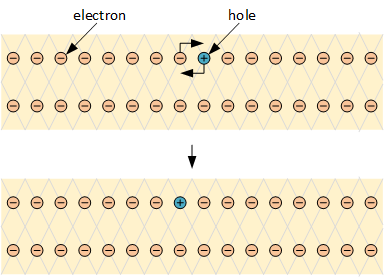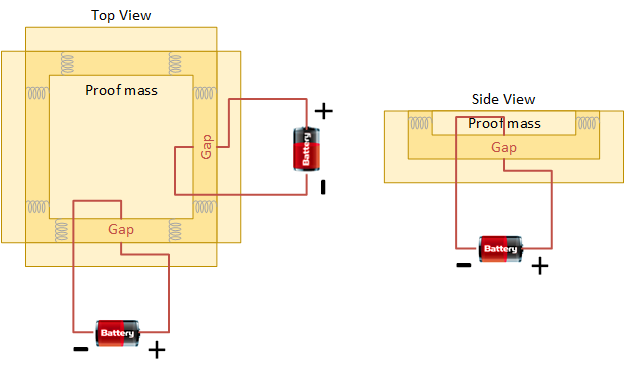
[From the last episode: We can design an accelerometer that measures all three dimensions, or degrees of freedomA setting or property that can be adjusted independently without affecting any other setting. With movement, there are three straight-line degrees of freedom: forward/backward, up/down, and left/right..]
OK, so, so far, we’ve seen that we can use small movements in our accelerometer proof mass to detect acceleration. And we can tell how much acceleration there is by how much movement there is. But how do you measure the movement?
There’s more than one way to do it, of course, but there’s one really common fundamental way that we’ll talk about. Then, just for flavor, we’ll talk about another completely different one.
By the way, some of this may sound really basic. It’s not my intent to talk down, but I really don’t want anyone left behind, so apologies if I explain something that, for you, needs no explanation.
When Electrons Really Love Each Other…
Actually, electronsA fundamental particle found outside atoms. It carries a negative charge. It can move easily in a conducting material, which gives rise to electrical current. don’t love each other. They are repulsed by each other. They are a charged particle, and charge comes in negative and positive flavors – just like a magnet has a north and south pole. Electrons happen to have negative charge, and they want to stay away from anything else with a negative charge. They’re attracted, however, to anything with a positive charge.
What has a positive charge? Well, protons do, but you don’t find protons wandering around aimlessly; they’re firmly bound to atoms, deep in the nucleus. Electrons, being on the outside of atoms, can peel off rather more easily (depending on the particular atom) and then move around in a currentThe amount of electrical flow. Measured in amperes or amps (A)..
Most materials have net zero charge; electrons balance protons. But if an electron gets up and leaves, then you have one less negative charge in that spot, which, since it used to be neutral, now feels like a positive charge. In siliconAn element (number 14 in the periodic table) that can be a semiconductor, making it the material of preference for circuits and micro-mechanical devices., these are literally called holesIn a material with specific places where electrons should be (like silicon), if an electron moves out of its designated spot, what’s left is called a hole. A hole effectively has a positive charge, and, as electrons move from hole to hole, it looks like the hole moves (even though, strictly speaking, it doesn’t – it just gets filled or emptied by a moving electron).; they’re the place where an electron should be and used to be but is no more. When electrons move around, they move from hole to hole – which makes it look like the hole is moving in the opposite direction. Now… the hole isn’t really moving, but engineers treat them as if they do – which works.*

Mind the Gap!
So you’ve got electrons and holes moving around in opposite directions. They move if you place “pressure” on them – like water pressure, except that, with electrons, we call that voltageVoltage is what gets electrons to flow. It's analogous to water pressure, which gets water to flow. Voltage is measured in units of "volts.". You might apply voltage, for example, with a battery. The voltage makes it feel like one direction is positive and the other negative. So the electrons get pulled to the positive side, while the holes want to go to the negative side. And they can do that as long as there is something for them to travel in – a conductorA material through which electricity can flow. Metals are a good, familiar example. like a wire or a semiconductorA material that, under some circumstances, can conduct electricity and, in other circumstances, cannot. like silicon.
But what happens if there’s a gap in that path? What if it’s not a closed path all the way?
Well, the first easy thing is that the current stops. If an electron stops at the gap, then it can’t move, and if it doesn’t move, then it doesn’t free up a hole for the next electron to jump to. So even though the gap is only in one place, the whole thing comes to a halt. It’s like a train: if the locomotive is blocked, then none of the other cars can move, even though they’re not next to the blockage.
But here’s the thing: if the gap is really small, then the electron on one side of the gap can still “feel” the hole on the other side, even though it can’t actually get there. And if the voltage is strong, you might collect up a bunch of electrons on one side of the gap and a bunch of holes on the other side. How many holes and electrons bunch up depends on how big the gap is (bigger means harder to feel the attraction across it) and what the gap material is (some materials are easier to “feel” through).
Another Capacity
This phenomenon is called capacitanceCapacitance is the ability of an electron or hole to “feel” other electrons or holes on the other side of a small gap. The gap prevents actual current from flowing, but, if small enough, electrons and holes can pile up on either side of the gap. Specific devices that make use of this are called capacitors., and there are electronic components called capacitors that do this. Turns out this is a good way to store up some electrons (the ones bunched up at the gap) for possible use some other time. (We won’t get into why that’s useful here, but, in the right places, it’s extremely useful – even critical).

The key for our story is the size of the gap. You can electrically measure the capacitance, which, since you would know the voltage and the material the gap is made of, measures the size of the gap. If the gap size changes, then the capacitance changes, and you can measure that. So all of those drawings in the last weeks showing a proof mass moving slightly? In all cases, they narrow (or widen) a gap, and you can use capacitance to judge the size of the gap.

Because the capacitance measurement is electrical, you now have a way to measure mechanical motion and turn it into an electrical signal, which was our goal.
But this is only one way to do it. There’s another accelerometer example that doesn’t rely on capacitance at all; it relies on heating a bubble of air and then measuring how it moves using thermometersA sensor that measures temperature.. Rather than spell it all out here, I’ll link you to an EE Journal article I wrote several years ago. Yes, that was intended for engineers, but it doesn’t rely on the reader having engineering knowledge.
And, with that, we’re done with accelerometersA sensor that measures acceleration and deceleration. – for the moment. Next week we’ll take a break and look at another company and industry making use of the IoTThe Internet of Things. A broad term covering many different applications where "things" are interconnected through the internet.. And then we’ll look at gyroscopesA sensor that detects when it changes direction..
*You might wonder, given pure silicon, with all electrons in place, how that first electron finds another hole to move to. If the silicon were pure and perfect, with no flaws, you couldn’t; there would be no holes because all electron spots would be filled with electrons. That’s why small amounts of other materials are added to silicon; they’re called dopants. Some are atoms with an extra electron; some are atoms with an extra hole. That provides the imbalance that helps get current flowing.

Leave a Reply